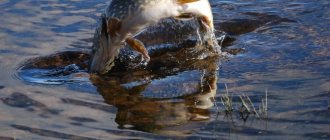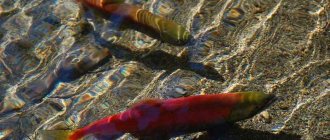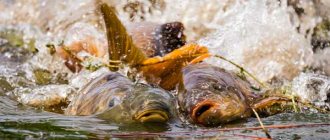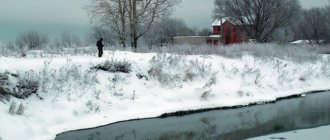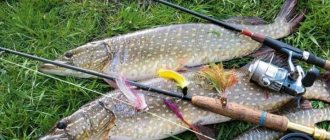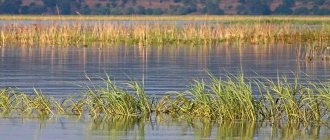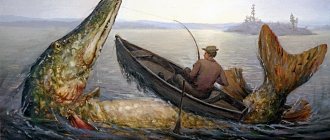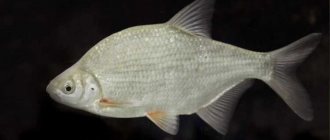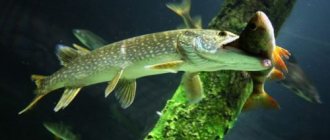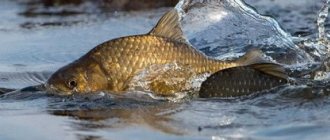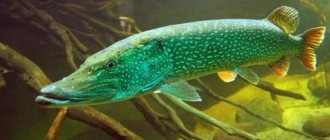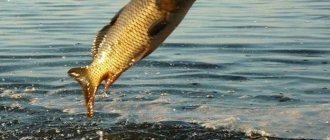When does pike go to spawn?
In spring, pike are among the first to spawn. This biological feature gives them an advantage over other species. Indeed, by the time pike become real predators and switch to food from small fish, the rest of the fish are just beginning to spawn. This allows you to protect your eggs, as well as attack other fish during the period when they are busy breeding. But even despite this feature, only 10% of the offspring survive.
When does pike spawn in central Russia?
The predator's first meal begins in February or early March, when it gains strength after winter. At this time, the fish usually comes to the mouths and absorbs all living things that come in its way.
In the spring, closer to April, when the ice in the rivers melts and the water warms up to 4-7? C, the spawning period of pike begins.
In closed reservoirs, where ice melts more slowly, pike spawn 3-4 weeks later. But it all depends on weather conditions: if winter lingers, it can begin to spawn under the ice.
Under normal conditions, that is, in the absence of weather disasters, the spawning time of pike lasts approximately three weeks. For an individual individual this period is 2-3 days.
When does pike spawning begin?
Pike spawning begins immediately after water bodies are cleared of ice, when the water temperature warms up from 3 to 6 degrees. Pike goes to spawn earlier than any other fish, since for the normal development of eggs and the appearance of juveniles, it needs cold water, more saturated with dissolved oxygen.
Pike spawning in spring (underwater filming):
Pike spawning time
Spawning time depends on the weather and type of reservoir. Pike spawn earlier in the upper reaches of small rivers, and the latest pike spawn in ponds and lakes, where the ice melts later.
In the middle zone, this moment occurs at the end of February - beginning of March. To the south, pike spawning begins earlier, in the north – later. The shift in spawning time may be associated with the early onset of spring or its delay.
As soon as the water temperature reaches suitable values, the sexually mature pike goes to spawn - it begins to look for a place to spawn - this is the move of the pike. She gathers in small groups, in which there are several males per female.
Spawning takes place in shallow water off the coast and in spills at a depth of up to one meter.
Female pike become mature in the fourth year of life, males a year or two later. By this time, young predators reach a size of 30 centimeters, weighing 400 grams or more. They are the first to begin the spawning season. A little later, medium and larger pike begin to spawn and it is they who bear the majority of the offspring.
Spawning of large pike:
A week or two after spawning, larvae measuring 7 mm in length hatch from the eggs, and having reached 1.5 cm, the bee-eaters already hunt for the larvae of roach and other carp fish that spawn later.
At what age does pike spawn?
Females reach sexual maturity by the fourth year of life. In the case when the reservoir has a good food supply and the fish are able to quickly gain weight - by the third. In males, this period begins only at the age of five. Young females spawn first, the largest ones wait their turn at the end of spawning.
By the age of 3-4 years, pike weighs about 400 g. Females are usually larger than males.
Throughout the year, pike live alone, but at this time they join groups and stop hunting. For one female there are from 4 to 8 males. The fish lays eggs on rocks, the bottom, bushes or grass. Depending on the size and age of the female, the number of eggs can reach up to 220,000. Under favorable conditions, fry appear after about a week. Initially, they feed on microorganisms, larvae, and insects. But in less than a month they are already able to attack small fish.
In terms of the quantity of caviar, pike is second only to perch and crucian carp.
Spawning time
As noted above, pike spawning is a process consisting of several stages, which are quite extended in time and amount to almost two months. Let's take a look under the water and see what the pike does in each spawning period. We immediately warn you that our time division is arbitrary; it may vary depending on regions and individual bodies of water.
- Mid March. The first melt streams penetrate under the water, the pike is cleared of leeches and begins to become interested in food. Catching it with girders at this time is most successful.
- End of March - beginning of April. The ice is melting, the pike is intensively fattening up. At first, she swallows any available fish, gradually replacing the diet with narrow-bodied fry: roach, bleak, dace and similar types of fish. Wider food puts pressure on the eggs and milt, causing great inconvenience to predators. Fishing in the ice is inconvenient with any gear, so our heroine is almost safe.
- Mid-April. The ice melted first on rivers, and later in standing reservoirs. The water temperature in some reservoirs reaches six to seven degrees Celsius, and this is a signal for the start of spawning.
- End of April - beginning of May. All pike generations have paid their debt to nature and are resting, restoring their strength. Gradually, the predator’s appetite grows, and she begins to eat.
- Mid-May. Zhor after spawning. The toothy fish actively feeds on live prey, so it is better to start catching it with a live bait rod. When the pike regains its strength, it will peck more and more actively on artificial baits.
Catching pike during spawning
The best time for hunting pike is considered to be the pre-spawning and post-spawning period, when the fish begins to eat. But do not forget that the size of its population directly depends on this period. Therefore, if you suddenly catch a pike at the end of winter or early spring, it is better to release it.
Penalty for catching pike during spawning
During the spawning period, the predator is very vulnerable - the fish loses its vigilance and can be caught with almost bare hands. But the law imposes a ban on fishing from February to early April (depending on the country and region). This is important to know so as not to get caught in unintentional poaching. Any decision regarding fishing at this time is made only by local authorities that are responsible for fisheries. They also set fines and prescribe penalties. Therefore, sanctions vary depending on the region.
The fine can reach up to 300,000 rubles. If you refuse to pay it, the violator will face an additional 15 days of administrative arrest.
There are rules that are introduced in reservoirs during the spawning period:
- a ban on movement on a body of water on a regular or motor boat;
- a ban on approaching the coastline by vehicle at a distance of less than 200 meters;
- ban on fishing in spawning areas.
About
When does pike spawn?
Pike spawning
the earliest among fish spawning in spring.
When the babies of other fish are born, the newborn squints are already mature predators. But things are not going as well for the squinting children as it might seem. After all, only 10% of pike offspring survive, and only 5% of them reach the age of one year. Such a low survival rate of young pike is required by many factors. For example, a sharp drop in water, after which not only eggs die, but also adult spawning individuals who do not have time to leave the spawning grounds and end up in pit traps. Pike spawning begins
when the water warms up to only 4-6 °C. This is approximately the end of March-beginning of April, depending on the region, the timing may vary. And the height of spawning begins when the water temperature reaches 7-13 °C. First, young, three-year-old pike go out to spawn, and then, in ascending order, larger and larger pike go to spawn and the spawning period ends with the spawning of the largest individuals.
A little history: fishing for pike during spawning
The fort was known back in Ancient Rus'. Catching pike during spawning often took place using this simple tool. This device is a stick with a pitchfork at the end and is used for fishing like a spear. Although it would be more accurate to say that it was used, because today it is classified as a prohibited weapon.
They started fishing in this way much earlier than with a hook or other gear.
Fishing with a spear was more like hunting. The most difficult thing in this process was to guess the distance from which the throw would be accurate, fast and not spook the prey. They tried to strike obliquely, aiming under the dorsal fin. Moreover, it was necessary to hit across the fish - this increased the likelihood of a hit. The spear was also used for beaming, the meaning of which was that at night shallow water was illuminated using fire, and later a lantern, and large fish were looked for. In this case, she either found herself sleeping or blinded. Once a suitable individual was found, it was slaughtered.
Where do pike spawn?
For spawning, pike choose small places, sometimes so shallow that its belly rubs along the bottom, and its back looks out of the water. It happens that pike spawn at points with a depth of only 5 cm, and the maximum depth that is suitable for pike for spawning is 1.2 meters. Pike spawns in places with a hard bottom, in thickets of reeds, reeds, and in areas with tree leaves or branches that have fallen to the bottom. Often, in search of suitable points, pike rises tens of kilometers upstream, enters thin rivulets and streams, or finds bays with a calm current.
When does pike start biting after spawning?
During spawning, the fish does not feed. Accordingly, it is useless to catch her. But even after this process is completed, you should not immediately go after the prey. After spawning, the pike needs to recover. This takes from 3-4 days to a week.
At this time, the fish is exhausted, often its body is covered with wounds and parasites (leeches and carp eaters). After a hunger strike and excessive activity, she weighs little, regardless of size. Due to its exhaustion, it resists weakly, so it is better not to take coarse gear and large baits with you. But in a couple of weeks the fish will recover, and then it will begin to have that same zhor that avid fishermen sing about. At the same time, you can catch pike after spawning with almost anything.
About
Features of spawning
Pike is a solitary predator, and individuals of this fish stay separately throughout the year. Each one chooses its own place for an ambush and protects it from other fish. A larger pike can displace a smaller one from a promising area, where the chances of catching a prey with minimal effort are highest. Spawning is the only time when these fish gather in groups.
Read more: When does the fishing ban start and end?
Female pike begin to spawn in the fourth year of life , and in reservoirs with a good food supply, where they quickly gain weight, already in the third . Males participate in spawning from the age of five years . The smallest pike spawn first, and large individuals do this at the end of the spawning period.
One female, depending on size and age, can lay from 17,000 to 220,000 eggs . Pike caviar is quite large, about 3 mm in diameter. It can stick to algae and flooded bushes, but it does not adhere to them well and easily falls off when shaken.
The eggs lose their stickiness within three days, after which they all end up at the bottom. The development of eggs takes two weeks in cold water and from one to one and a half weeks if its temperature is higher. At the end of this period, larvae emerge from the eggs, about 7 mm long , which have a bubble with nutrients on their abdomen.
When it resolves, the pike emerging from the eggs switch completely to independent feeding. At first, their main diet consists of small crustaceans that swim in the water column. Then the pike fry switch to feeding on the larvae of other fish, which have also recently hatched from eggs.
Prohibitions during pike spawning
So is it possible to catch pike during the spawning period? In each individual region, restrictions on pike fishing during the spawning period are legally established. In order to avoid getting into an unpleasant situation, before going fishing you need to familiarize yourself with the accepted prohibited documents.
Read more
How to choose a spinning rod for a beginner?
The ban most often applies to:
- I fish with a spinning rod;
- travel by boat, as well as a boat with a motor on a pond;
- I catch pike during spawning completely.
Violation of the requirements of these documents results in administrative liability in the form of a fine for spawning fishing, or even criminal liability. Fishermen who do not comply with spawning bans may be forced through the courts to undergo corrective labor.
Fishing for pike during spawning is prohibited, and the time of the spring ban is announced every year for each region for each water area separately
In some regions, fishing from the shore is allowed during the spawning season. Conditions for such permission:
- large distance from spawning grounds;
- fishing with a float rod;
- Donk fishing with a limited number of hooks.
Fishing for pike with a spinning rod is prohibited almost everywhere. But even the permitted methods of catching pike for spawning usually do not justify the damage that such fishing can cause to the population of this fish species.
How does pike behave before spawning?
Spinning fishermen, getting ready for spring fishing, often wonder: do pike bite before spawning? It should be remembered that as soon as the water in the reservoirs warms up to 4-8 degrees, the spotted predator goes to spawn, and before that it experiences a period of increased feeding activity - the pre-spawning glutton.
Read more
Fishing with a retractable leash: detailed instructions for beginners
The spawning process begins in late March or early April, depending on weather conditions
It is during this period that you can catch fairly large specimens of fish on the approaches to spawning grounds at medium depths, when females lose their vigilance and rush to any bait.
But before spawning, pike does not rush to large bait, since its belly is densely filled with caviar and the basis of its diet is small fish.
